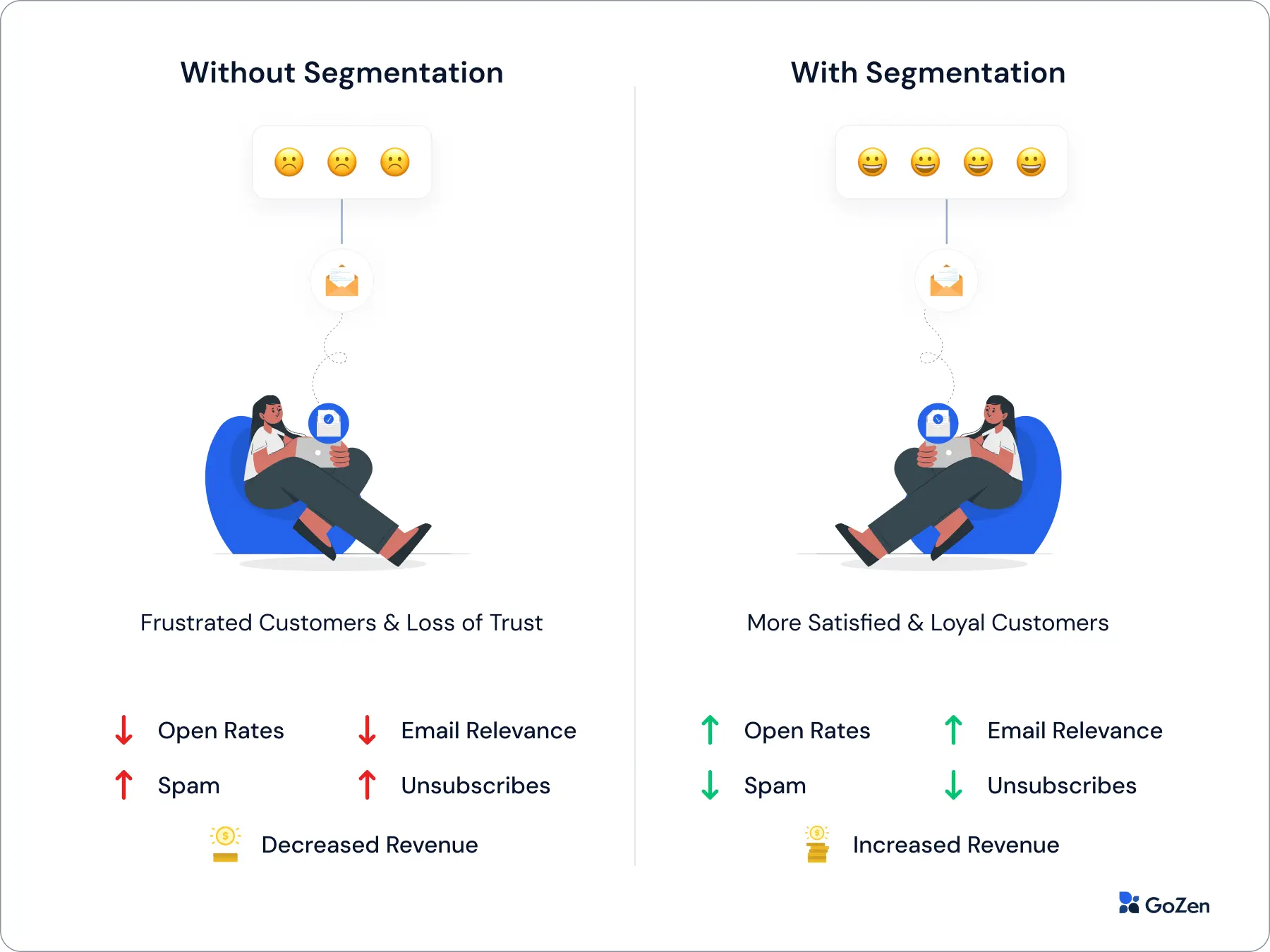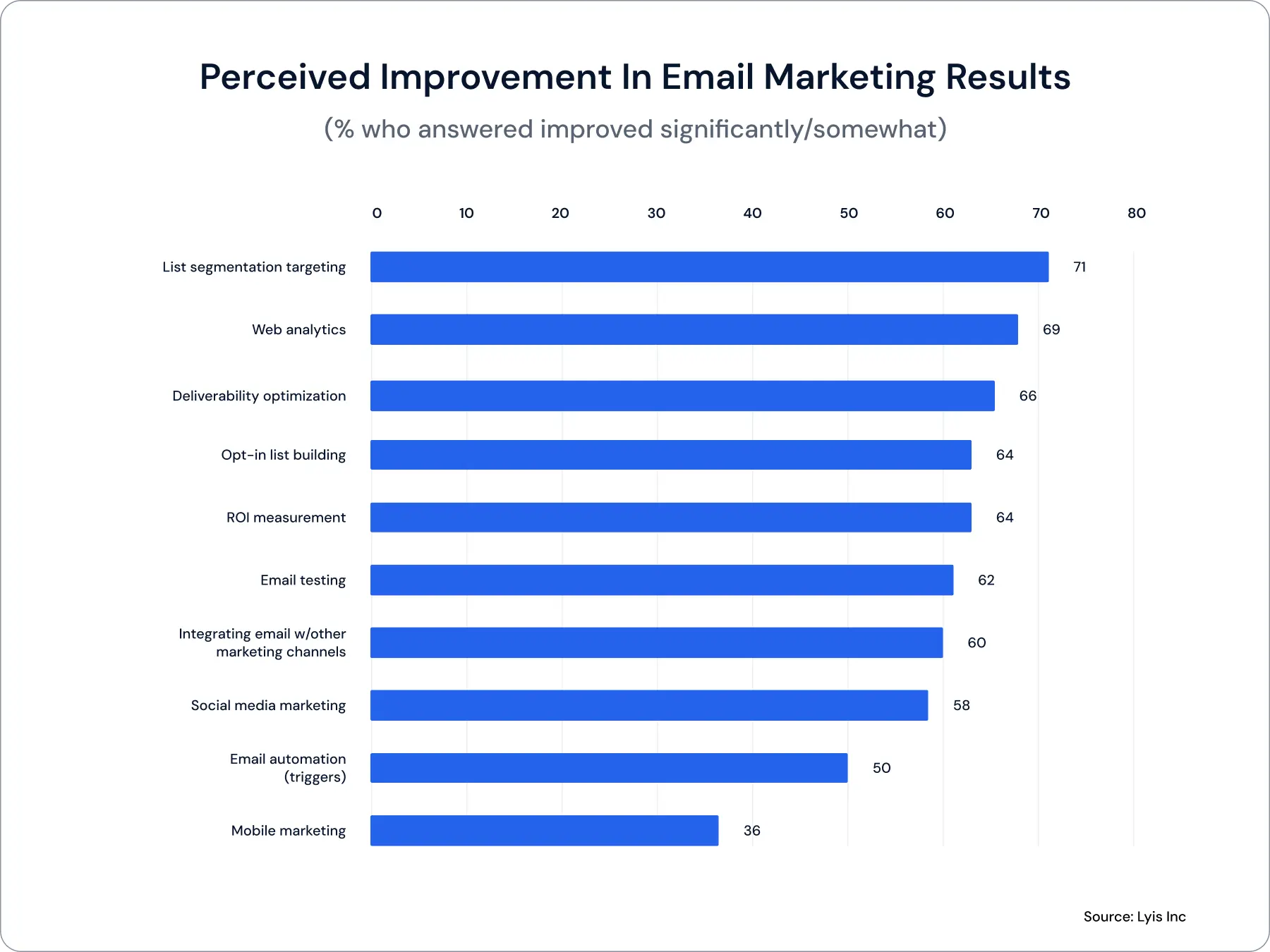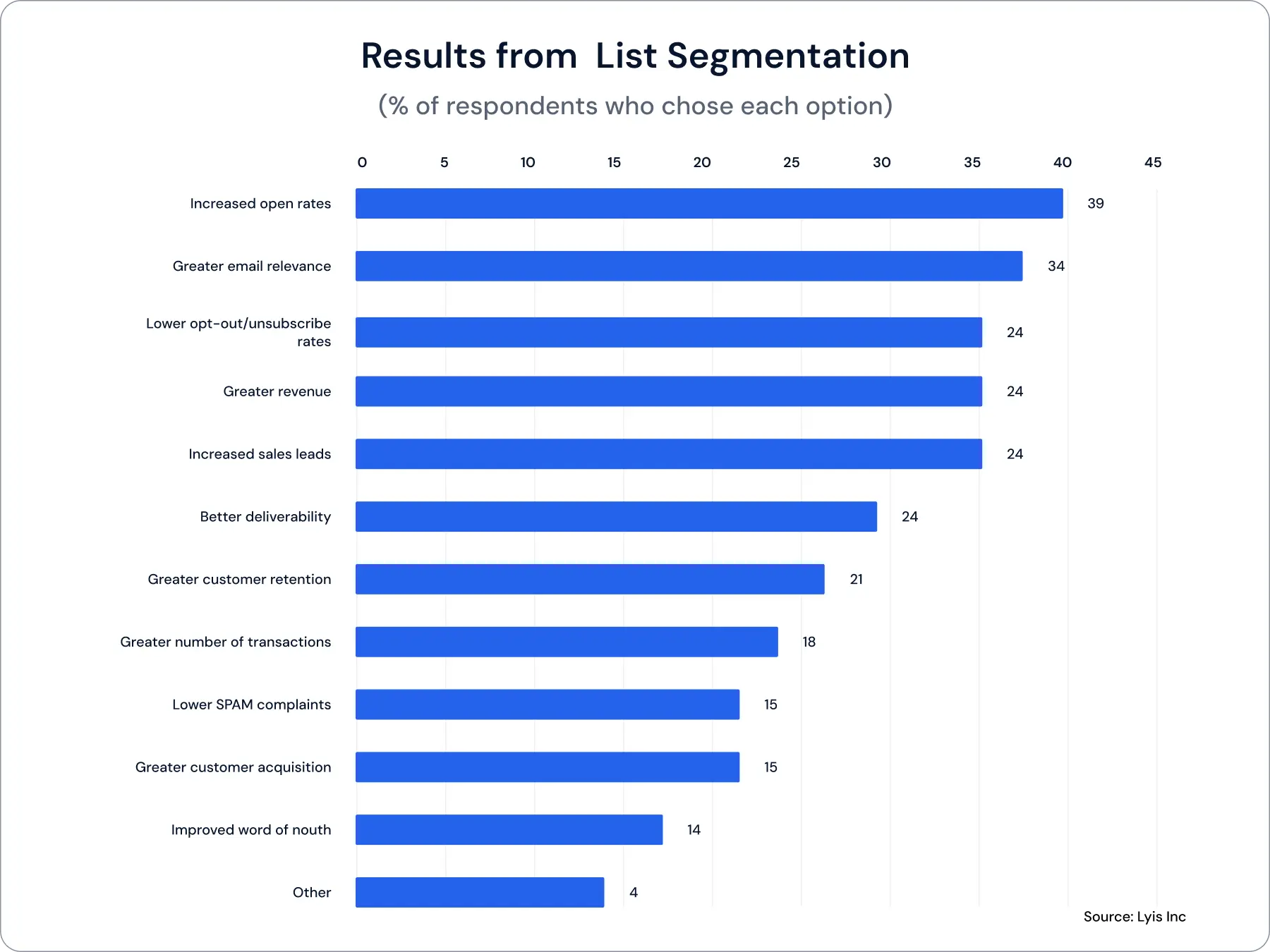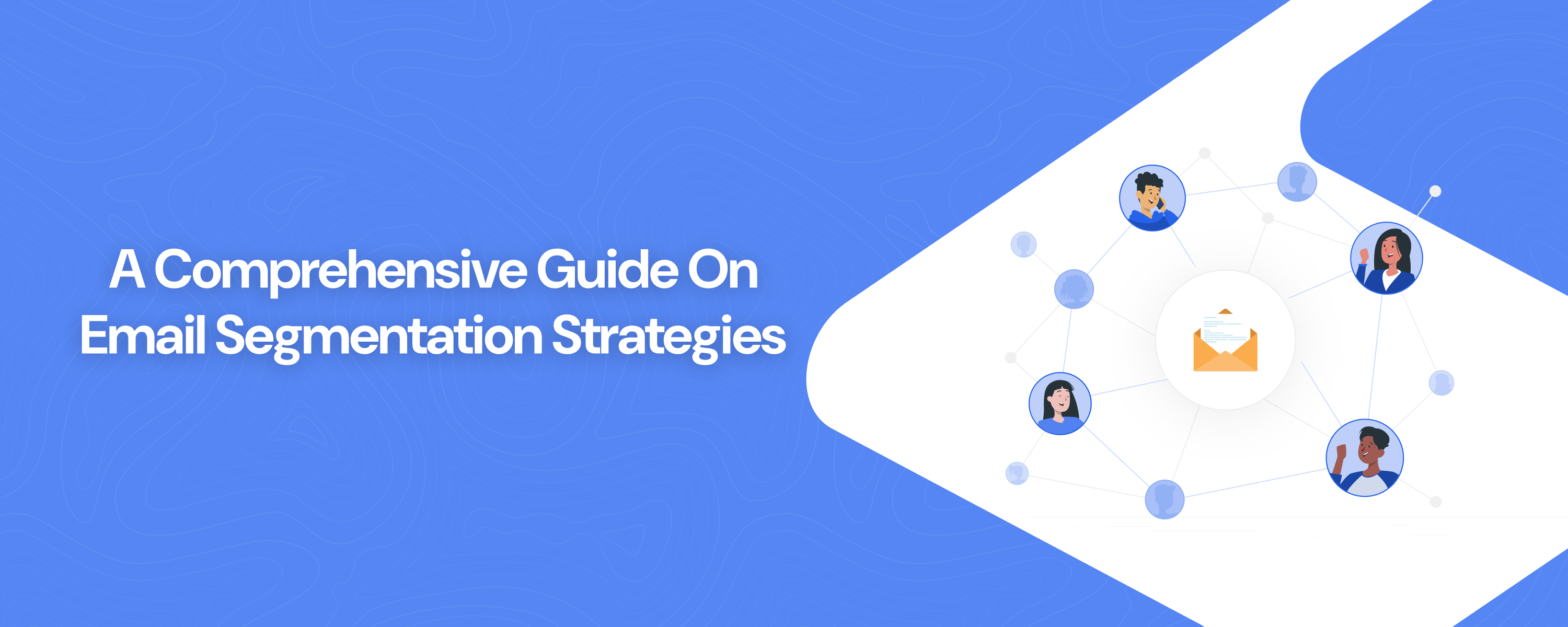There are 4.48 billion email users globally and about 361.6 billion emails are sent daily. From this fact, it is evident that email plays a significant role in any winning marketing strategy. A recent study by Forbes reveals that 50% of marketers have stated email marketing to be their most impactful channel. With these statistics and inboxes overflowing with messages, making your brand stand out and grab your audience’s attention is a crucial feat.
Ignoring segmentation might make you send generic and irrelevant content to your entire database. And when they feel that your content does not provide any value to them, they might become unengaged. This is where email segmentation acts as your strategic weapon.
What Is Email Segmentation?
Email marketing segmentation is a way of breaking down your recipient list into smaller and more targeted groups based on shared characteristics. By segmenting email lists, you can transform your email campaigns from generic blasts to personalized and high-converting messages.
Think of it like this:
You would send a funny meme to your friend but stick to a formal talk with a faint acquaintance.
Similarly, categorizing into email marketing segments creates these distinctions within your audience segments and allows sending messages specific to each audience group.
Why Is Segmentation Important in Email Marketing?
Unlike other mediums for widespread communications, email facilitates curating content for a narrowed audience rather than sending bulk irrelevant mails. There are several benefits of email marketing audience segmention which allows to customize the message content to the needs and interests of each group. This ensures that your audience receives messages that are relevant and provide value to them.
By leveraging well-structured email marketing segmentation techniques, your email better resonates with your audience fostering engagement and ultimately persuading them to take actions such as conversions or brand loyalty.

What Is the Difference Between Email Segmentation and Personalization?
While email segmentation and personalization may often be used interchangeably, both of them serve distinct purposes.
The Impact of Segmented Email Lists
A recent study throws light on the impacts of email marketing.
The data shown below illustrates that 71% of marketers who have frequently carried out segmenting email lists have seen improved results.

Specifically, it can be seen that there are 39% increase in open rates, while 34% of marketers noted greater email relevance. Furthermore, 28% observed lower unsubscribe rates, underscoring how segmentation not only enhances engagement but also improves overall email campaign performance, contributing to increased ROI, customer retention, and better deliverability.

Source:Lyris Inc
Ways to Segmenting Email Lists for Targeted Campaigns
There are several ways in which you can segment email lists for targeted campaigns on the basis of shared attributes of your audience.
Personalized emails are more than just mentioning your audience’s name in the email, it’s about tailoring messages to their needs and preferences. A well-prepared segmentation list paves the way for a successful email marketing strategy. Segmenting email lists are of various types.
Now, let’s take a quick look at each of those types!
| S.No | Segmentation Type | Overview | Example Criteria | Ideal For |
|---|---|---|---|---|
| 1 | Demographic | Based on personal attributes | Age, Gender, Income, Education Level | Personalizing content and offers |
| 2 | Geographic | Based on location | Country, City, Region | Local promotions and event notifications |
| 3 | Psychographic | Based on lifestyle and values | Interests, Values | Aligning messages with recipient’s lifestyle |
| 4 | Firmographic | B2B segmentation by company characteristics | Industry, Company Size, Revenue, Employees | Tailoring solutions for different business types |
| 5 | Behavioral | Based on user actions | Purchase History, Website Activity | Targeting based on past behavior |
| 6 | Engagement Data | Based on email interactions | Open Rates, Click Rates, Inactivity | Enhancing engagement with tailored content |
| 7 | Preference | Based on user preferences | Preferred Products, Content Topics | Customizing offers and content |
| 8 | Lifecycle Stage | Based on customer journey stage | New Leads, Active Customers, Former Customers | Targeting at different stages of the customer journey |
| 9 | Persona-Based | Combining various data for detailed personas | Demographics, Psychographics, Behavioral Data | Crafting messages for specific customer personas |
14 Proven Email Segmentation Strategies to Elevate Your Campaigns
Now you have gained sufficient knowledge on various types of email segmentation, let’s take a look at 15 creative email segmentation techniques for targeting the aforementioned groups to improve various email marketing metrics and ultimately enhance customer loyalty and purchases.
1. Welcome New Subscribers with Personalized Onboarding
Build segmentation lists with those who have recently subscribed. Lay the foundation for a positive relationship by implementing an onboarding email series.
By this way, you can introduce your audience to your brand, highlight features, and stimulate interaction with your content.
2. Reward Your Most Loyal Customers
Appreciate your loyal customers with exclusive offers and special deals.
Segment email list to identify customers that possess high value by way of frequently engaging or making purchases. Provide them with special rewards to enhance their loyalty.
3. Divide Your B2B and B2C Audiences
Create distinct segments for B2B and B2C audiences to provide personalized messages.
B2B audiences tend to prefer content that is relevant to their business such as pricing information in bulk or industry insights.
On the other hand, B2C audiences are the ones who are more interested in promotions and new product updates.
4. Target High Open Rate Subscribers
Develop a list segmentation by identifying subscribers who open your emails regularly and cater to their interests.
These are the kinds of engaged readers who are ideal for receiving exclusive content, special promotions, and opportunities for feedback.
5. Re-engage Inactive Subscribers
Some subscribers might show low or minimal engagement. Establish a customer email list segment to re-engage them.
Employ different email marketing segmentation testing practices such as altering the frequency of emails or offering special incentives to rekindle their interest without annoying them.
6. Appreciate Regular Buyers With Targeted Offers
This can be done by segmenting frequent buyers to provide them with exclusive promotions and updates.
Using purchase history, you can personalize to offer deals or new product promotions and updates that align with your customers’ buying patterns.
7. Remind Abandoned Cart Shoppers
Form a mailing list segmentation targeting users who have abandoned their carts.
Construct campaigns for these customers by sending follow-ups to encourage them to complete purchases by offering discounts or free shipping.
8. Notify Customers About Restocks
This is the segment where you take your database of customers who have expressed interest in the products that were once out of stock.
So, when this previously out-of-stock item becomes available again alert those who come under this segment.
9. Nurture Leads Through the Sales Funnel
Organize audience segments based on their stage in the sales funnel.
Captivate the attention of warm sales leads with product benefits and calls to action. You can also nurture other segments with relevant email content based on their history of interactions with the brand.
10. Address Changes in Customer Behavior
Based on changes in customer behavior, create a segmented audience list for those who have reduced their purchase frequency.
Execute strategies for re-engagement by conducting surveys to analyze what might have caused their behavioral change and understand their evolving needs.
11. Segment by Job Roles in B2B
Set up B2B audience segments based on specific job roles or departments to customize mails addressing their unique roles and responsibilities
This can be for procurement managers, IT professionals, C-level executives, and more
12. Customize Messaging Based on Devices
Device-based email marketing segments are created based on the device subscribers use to open the emails.
The needs of those who predominantly interact with your content on mobile devices are different compared to desktop users specifically when it comes to user experience, purchase patterns, and even email design.
13. Tailor Content Based on Website Activity
This is one of the customer segmentation ideas for segmenting email contact lists based on their activity and behavior on your website.
It can be about the pages they’ve visited, products they’ve browsed, or the frequency of interaction with your site.
14. Differentiate Between Budget and Luxury Shoppers
Launch segmented email campaigns based on spending patterns such as budget-conscious customers vs those seeking luxury.
For each of these groups, present specific promotions, offers and product suggestions that align with their spending behaviors and interests
As you implement the above-mentioned strategies you must also be prepared to continuously monitor the performance of segmented campaigns, analyze results, and adapt strategies to your audience’s ever-changing needs.
Start small, experiment with different segments, and adapt your strategy over time.!
Email Segments vs. Cohorts
Both cohorts and segments play a significant role in refining your email marketing strategy for targeted campaigns. But how do they differ, and why should you care? Let’s break it down!

Email segments are the starting point of personalization. They are like buckets where you place your subscribers based on shared characteristics.
Now, cohorts are the ones elevating segmentation. If segments are your starting buckets, cohorts are more similar to focussed containers within those buckets. It groups your recipients based on a shared experience or behavior over a period of time.
While segmentation is great for immediate, targeted communication, cohorts offer deeper insights by examining trends and patterns over time. By analyzing cohorts, you can dig deeper into long-term patterns, evaluate the impact of changes in your strategy, and refine your approach based on historical data.
Wrapping Up
Email marketing does not simply work on a one-size-fits-all approach.Each subscriber is unique. Generic email blasts do not necessarily work with today’s crowded inboxes.With effective email campaign segmentation, you can personalize messaging ensuring that your audience receives relevant content tailored to their needs and preferences and that provides value to them.
This strategic email segmentation not only improves engagement and conversions but also cultivates long-term customer loyalty and helps build meaningful connections.
With a focus on providing relevant and personalized content that provides value to your audience, you can ensure that your email marketing efforts yield improved deliverability, stronger engagement, higher open and click-through rates, reduced spam and unsubscribers and maximized ROI.
Make every email count. Don’t let them get lost in crowded inboxes.
Send the right message to the right people!



